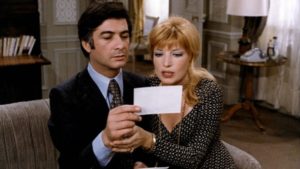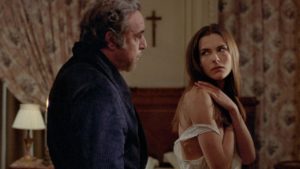STUDIO: Criterion Collection | DIRECTOR: Luis Buñuel | CAST: Fernando Rey, Paul Frankeur, Delphine Seyrig, Bulle Ogier, Stéphane Audran, Jean-Pierre Cassel, Jean-Claude Brialy, Adolfo Celi, Michael Lonsdale, Michel Piccoli, Jean Rochefort, Milena Vukotic, Monica Vitti, Carole Bouquet, Angela Molina
RELEASE DATE: 1/5/21 | PRICE: Blu-ray $69.99
BONUSES: Speaking of Buñuel, a full-length documentary from 2000 on Buñuel’s life and work; “The Castaway of Providence Street,” a 1971 homage to Luis Buñuel by Arturo Ripstein and Rafael Castanedo; a 2011 television program about the making of Discreet Charm; interviews from 2000 with screenwriter Jean-Claude Carrière; archival interviews on all three films featuring Carrière, actors Stéphane Audran, Muni, Michel Piccoli, and Fernando Rey; and other key collaborators; 1985 documentary about producer Serge Silberman; analysis of Phantom of Liberty by film scholar Peter William Evans; a 2017 documentary featuring actors Carole Bouquet and Ángela Molina; a 2012 short documentary featuring director of photography Edmond Richard and assistant director Pierre Lary; excerpts from Jacques de Baroncelli’s 1929 silent film La femme et le pantin
SPECS: NR | 308 mins | Foreign language comedy-drama | 1.66:1 | mono | Optional English subtitles
Throughout the supplemental materials in the Three Film by Luis Buñuel collection we hear that the master, Don Luis Buñuel, considered himself “too old” to still be making films in his 70s. That notion has, of course, changed in the years since Buñuel made the three films found in this set, which were his last. Thanks to figures like Manuel De Oliveira in the arthouse world and Clint Eastwood in the multiplex mainstream, there is now no “expiration date” on careers in filmmaking.
There is the tendency, however, to look on these last films by Buñuel as the “summation” of his art. This is partly true, but when a filmography begins with Un Chien Andalou it’s hard to imagine Buñuel had much to learn — only modifications and modulations were necessary.
The foremost collaborator on six of Buñuel’s last eight films, co-scripter Jean-Claude Carriere, notes throughout the supplements that two of the films collected here, Discreet Charm of the Bourgeoisie (1972) and The Phantom of Liberty (1974), belong to a loose trilogy with the (now out of print on disc) 1969 film The Milky Way — all three being experiments in a sort of “wandering” narrative. The final experiment that Buñuel cooked up for the much more linear That Obscure Object of Desire (1977), included here, does link that film to the other two, which are much broader, ensemble-driven pieces.
Discreet Charm was an Oscar winner for Best Foreign Language Film and it may well be the most accessible of all Don Luis’s work. The episodic tale of a trio of haute bourgeois couples who can never quite get to eat their dinner is awash with unforgettable twists and turns, including the fact that not just one but four characters awake from dreams.
Phantom of Liberty contains an extreme experiment that has rarely been done before or since — Richard Linklater’s Slacker (1990) duplicated it, with varying success. A sequence of characters are followed, with the narrative being “handed off” from one protagonist to the next. In this way literally almost anything can happen, and indeed does.
Obscure Object has a linear storyline (from the novel that von Sternberg turned into The Devil Is a Woman in 1937). Here, however, Buñuel hit upon one of his stranger (and ultimately enticing) artistic decisions — to have two dissimilar actresses (Unforgivable‘s Carole Bouquet and Angela Molina) play the lead role of the teasing seductress pursued by a wealthy man (Fernando Rey, Tristana). The film includes a few key diversions, including a theme common to all three films found in this collection, that of urban terrorism striking unexpectedly on city streets.
Taken as a trio, the films may not present any kind of “final statement” by Buñuel, but they do stand as works made by an older artist who was still very eager to play with the viewer’s perception and toy with the very nature of cinematic storytelling.
While the films run a total of five hours, the supplements run more than six hours. Aside from interviews with Jean-Claude Carriere (Pierre Etaix) shot for Criterion in 2000 (and an academic speaking in 2017), the extras originated as European television programs or independent documentaries.
The longest piece is a 100-minute documentary by Jose Luis Lopez-Linares and Javier Rioyo called Speaking of Buñuel (2000). The narration comes from Buñuel’s autobiography My Last Sigh, while the talking heads range from family and friends to noted admirers (including novelist Carlos Fuentes) and actors who worked for Don Luis, including Silvia Pinal (The Exterminating Angel), Michel Piccoli (La Belle Noiseuse), and Stephane Audran (Babette’s Feast).
The doc touches on the major topics associated with the filmmaker, like surrealism, atheism, and, of course, filmmaking. Of particular interest are comments from friends about Buñuel’s deadpan sense of humor (which did include the occasional prank on a cast member) and his very deep feelings that sex shouldn’t be seen onscreen — and neither should kissing.
So, one gets to hear about the ultimate prank for the early 20th century — when entering a staid, old-world Spanish gentleman’s club, Buñuel told his friend Salvador Dali to kiss him on the mouth as if the two were lovers — while also finding out that (while his leg and foot fetish was fairly apparent to most alert viewers) Don Luis thought kissing should only be seen very briefly in film. He summed up his feelings in the aphorism “Sex without sin is like an egg without salt.”
A short doc co-directed by Rafael Castanedo and the noted Mexican filmmaker Arturo Ripstein (Time To Die) explores Buñuel’s obsessions, including entomology and the proper mixing of drinks. Included is footage of the rarely-interviewed-on-camera Don Luis showing us how he made his trademark drink “the Buñueloni.”
There are behind the scenes featurettes about all three films, and clips from tribute television shows. In the central piece about Discreet Charm, we hear about the film’s political level from one-time French radical (later a respected member of the government) Daniel Cohn-Bendit. The cast supply stories about Buñuel, with the best being that the pace of the film’s most memorable repeating image — the three bourgeois couples walking down what seems to be an endless road — was determined by Buñuel assuring the cast members that “whoever walks the fastest gets a close-up.” Thus, the rather brisk pace of that sequence.
The supplements for Phantom of Liberty explore its many plot strands and also its unique construction. In this respect co-scripter Jean-Claude Carriere is the most invaluable commentator, for obvious reasons. He notes that his mentor and collaborator told him that they should move from one storyline to another, providing “moments of possible stories” that are “ambiguous and contradictory.”
This off-kilter approach to storytelling led to the creation of the segment that Carriere cites as being Buñuel’s personal favorite plot strand — an odd and funny sequence of scenes in which parents declare their young daughter missing while she is standing right next to them. Buñuel builds the concept by having the parents go to the police, at which point the police commissioner makes detailed notes about the “missing” girl by looking at her in person. (It’s the kind of oddball concept that works best onscreen and can’t be communicated well in print.)
Fernando Rey, the star of Obscure Object and friend of the filmmaker, speaks in a featurette on that disc about the fact that Buñuel took great care in blocking his actors. This, Rey contends, was most likely because the filmmaker never used musical soundtracks in his later work (only ambient music being played onscreen or on glimpsed record players or radios). Thus, “[Buñuel] looks for rhythm in the movement of the actors,” breaking down the action in an almost unnatural way (adding to the dreamy nature of the proceedings). “You can’t talk and hold a glass at the same time,” Rey notes. “You have to show the glass and then talk… everything you normally shouldn’t do, but with him, it looks amazing onscreen.”
The most interesting divergence of opinion concerns the use of two actresses to play one role in Obscure Object. The actresses themselves speak at length in a very interesting featurette about their both playing the role of “Conchita.” The part was originally being played by Maria Schneider (Last Tango in Paris), who apparently was having great difficulty on-set. Thus, Bouquet and Molina were both brought to the set to audition with Fernando Rey, and Buñuel made the unusual decision to use them both.
The actresses don’t discuss the “meaning” of this device, but they do delve into the way it affected their performances — Bouquet notes that she was given less support by Buñuel, who had more of a tactile, parental relationship with Molina. They also note that some (seemingly oblivious, as the actresses do not look alike) male viewers never realized there were two actresses playing Conchita.
In another featurette, assistant director Pierre Lary and cinematographer Edmond Richard describe the lead-up to the decision to cast both women, making it sound as if Bunuel made the decision spontaneously on the day the shoot was set to resume (after the departure of Schneider).
Carriere contradicts this elsewhere in the supplements, noting that Buñuel had earlier on mentioned the possibility of Conchita being played by two women in one of their many discussions of the script. The master stroke, and the thing that makes the device so bizarre (even to those rewatching the film after having seen it several times) is that, while it is clear on one level that Molina is playing the “hot” side of the character and Bouquet the “cold” side, Buñuel told Carriere they should assign certain scenes to the “wrong” actress for that particular scene. Thus, the two women would become “interchangeable.”
Most of the talking heads seen in the supplements concentrate on the way that Buñuel the artist was just one manifestation of Buñuel the man, who seemingly got along quite well with his cast and crew. One commentator, though — film scholar Peter William Evans — holds down the academic side of the equation by analyzing Phantom in detail and assigning specific Freudian meaning to the characters and their behavior.
The best item he presents is that Buñuel, an artist who mocked individuals on both sides of the political spectrum and the apathetic bourgeoisie as well, took care to include patriotic Spanish characters in Phantom who proudly proclaim to the French soldiers who are about to execute them the eternal cry of the political submissive, “Long live our chains!”
|
Buy or Rent Three Films by Luis Buñuel
on Blu-ray
|
|---|



Leave a Reply